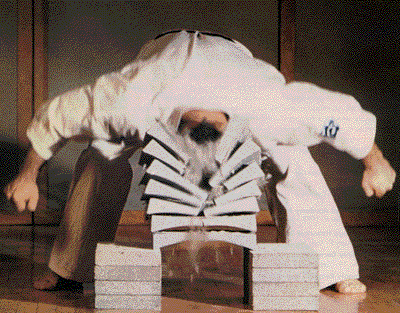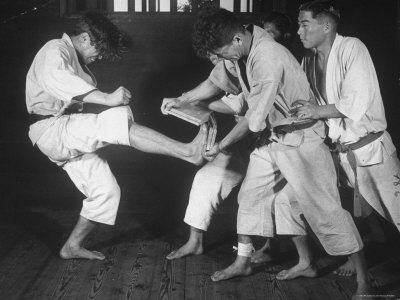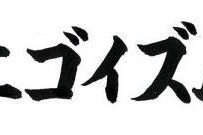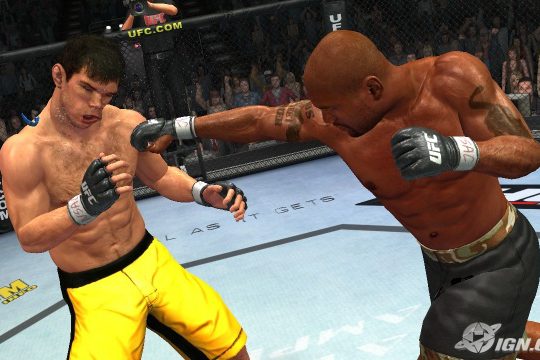The crowd in the shopping mall went silent…
All you could hear was the Rocky soundtrack (Eye of The Tiger) playing in the background, as I stood on the stage and slowly pulled my elbow back in preparation for breaking the slab of fake concrete in front of me.

My inner sensei was speaking to me: “Pretend to focus, Jesse-san… it must look like it’s really hard to pull this off. Remember to add a loud kiai to make it even more spectacular. This should get you tons of chicks for sure… a few seconds more… NOW!”
HAIYAAA!!!
BAM!
*pieces of fake concrete flying all over the place*
WOHO!!! *crowd screams*
And that’s the story of how I instantly got 20 new member to our Karate club, like ten years ago or something. Easily.
By doing a super fake tameshiwari (breaking) demonstration for an unsuspecting audience of youngsters at the local mall.
And you can do it too.
Tameshiwari, the act of breaking stuff (like ice, wood, bricks, concrete, roof tiles and such) is something all people immediately recognize as Karate. Perhaps most famous in the style of Kyokushin (full contact Karate), tameshiwari is a surefire way to impress even your half blind granny, since it’s such a visually impressive feat understood by everyone.
Perfect for demos and/or bachelor parties.
Well… unless you do it the real way.
You see, as with everything in life, tameshiwari isn’t all black and white. It’s not just breaking or not breaking. It’s also about how, what and why you break stuff. And in general, there can be said to be two main categories of tameshiwari.
A quick definition would be something like:
1. Real tameshiwari
Real tameshiwari is the kind you don’t want to be doing unless you are a bit crazy. Popularized by the founder of Japanese Kyokushin Karate, namely Masutatsu Oyama, it involves few safety measures (except your (hopefully) super hardened body) and is more a test of will power, physical strength, technique, lunacy and mental focus than anything else.
In fact, real tameshiwari is considered such an awesome feat that it is actually an official part of Kyokushin-kai tournaments, where participants are known to break practically every bone in existence during their unforgiving hunt for the gold medal. The more boards you break, the bigger the chances are of winning. As unglamorous as it may sound though, real tameshiwari practitioners are some of the most respected people you’ll meet in Kyokushin circles, as they are known for being almost superhuman.
Real tameshiwari is just as genuine, and just as hard, as it looks.

2. Fake tameshiwari
Fake tameshiwari, on the other hand, is exactly the opposite. A real crowd pleaser indeed, this type of breaking is 100% pure entertainment and showing off. Truth be told, the pursuit of more and more spectacular ways of breaking stuff has created a whole industry centered around (easily) breaking stuff in front of roaring crowds; with baseball bats made of balsa wood, hollow blocks of concrete and ice, fake movie glass (a.k.a sugar glass), pre-cracked boards and other dubious martial arts products as result. The bigger the object to break – and the more it shatters – the better it is.
The most famous practitioners of this “sport” are often holders of several suspicious “world records” in various forms, yet often they prove to be better at special effects than actual martial arts…

[Fun side note: The forbidden technique in UFC of downward elbows is a direct consequence of these fake tameshiwari demonstrations. As the story goes, a member of the Nevada Athletic Commission (they regulate the rules of MMA, including the UFC) once witnessed a breaking demonstration where some Karate guy used a downward elbow strike to shatter a seriously respectable amount of ice. The commission man was so convinced that he had just bore witness to such a deadly technique that from that day onwards the act of dishing out downward elbow strikes became totally forbidden in MMA leagues like the UFC. The fun thing is, it still is! Ha!]
So now that you know about the two main categories of tameshiwari, let’s pretend you actually want to try your hands (or feet!) at this thing.
Where to begin? How to do it? I’ll attempt to give a brief walkthrough of the most important aspects when it comes to breaking, whether your purpose is for grading (many schools require tameshiwari for black belt), demonstration, tournament or just as a fun pastime activity.
Choose Your Weapon Wisely.
 There are more risky ways of doing tameshiwari, and there are less risky ways of doing tameshiwari. The degree of riskiness is closely associated with what part of the body you choose as your weapon for the breaking. Safe choice? Stomp. Preferably with shoes on. The feet are made for walking, jumping and stomping on things, and will therefore be easy for anyone to quickly master.
There are more risky ways of doing tameshiwari, and there are less risky ways of doing tameshiwari. The degree of riskiness is closely associated with what part of the body you choose as your weapon for the breaking. Safe choice? Stomp. Preferably with shoes on. The feet are made for walking, jumping and stomping on things, and will therefore be easy for anyone to quickly master.
However, if that’s not impressive enough, elbow and knee comes in second – although Mother Nature definitely did not design neither elbows nor knees to be used for breaking things.
A little higher on the riskiness scale we find the fist. And unless you know what you’re doing, keep it closed. A strong hand is a closed hand. Hammerfist is recommended over straight punch (seiken) all day every day.
Lastly, the exotic classic of slamming your forehead into a stack of bricks isn’t as stupid as it initially seems, since the cranium is surprisingly tolerant to resistance – but it’s nevertheless attached to your neck, which isn’t the strongest of bodyparts.
Unless you nickname is The Machine.
(Don’t) use your head, okay?
Stiffness = Success.
An often overlooked factor in tameshiwari is the stiffness of both the material you’re about to break – wood, concrete, ice, etc. – as well as the floor.
Judo mats? Springs under the floor? Grass? Check it out.
These are the things that can make or break (haha!) any tameshiwari attempt. If your force is absorbed by a soft or bendable material, things have a tendency to *not* break as they should.
And believe me, I’ve seen too many demonstrations of Uechi-ryu stylists in Okinawa trying to desperately break baseball bats over and over again to know that it’s just as embarassing for the onlookers as it is for yourself.
Don’t be that guy.
Always make sure everything is as rigid and stiff as possible, before you try chopping anything to pieces.
Comprende?
Stack Like a Pro.

The more bricks you break, the cooler it looks. We all know that. But, there’s an astronomic difference between cracking boards stacked directly on top of each other versus cracking boards stacked with some space between each layer. Obviously, the same goes for bricks, roof tiles, ice and anything else you might want to break.
You need space between the layers.
Why? Because if you stack the material without spaces the degree of difficulty will double for every level you add(!), whereas the difference in difficulty of breaking five, ten or twenty boards will be hardly noticeable if you divide the boards with space between.
In classic Kyokushin tameshiwari they stack the boards without space, and thus five or six boards is around maximum even for elite Kyokushin-ka! However, slide in a couple of small dividers between the boards and suddenly something magical happens: you can easily triple the height of your stack – making for a considerably more impressive show!
With really high stacks it might even become easier to do the breaking when you have space between, since the weight of the top layers will aid you in breaking the rest as you chop down.
In conclusion, spaces are your friends.
Wood, Ice or Bricks?
Choosing material is super important.
- A very easy and cool choice is ice. It’s cheap too. All you need is a semi big freezer and some time. The advantages of breaking ice are obvious: It looks harder than it actually is, it’s unconventional (compared to bricks and boards), it’s technically uncomplicated to make and it looks quite spectacular when it shatters. Also, you can use pretty thin slices of ice (½ inch or 1-2 cm is enough), since it looks almost as impressive as thicker slices would.
- Wood is another favorite. But the hard part about wood is finding the right type. Boards are traditionally made for resisting force, and the sad truth is that most boards can easily resist even your mightiest Karate chop, Chuck Norris-style roundhouse kicks included. Indeed, during the 80’s golden days of tameshiwari, many people were known to break both fists and feet in naïve attempts at breaking boards that were either not stiff enough or not dry enough (wet boards = bad idea). Also, it goes without saying that you should never break against the grain! Look at the fibre before attempting anything stupid.
- Roof tiles are hardcore. The good news is that they’re not really meant to be punched at, while the bad news is that they have a weird surface that will make the force of your blow spread unevenly over the tile. Therefore “judo chops” (shuto) are preferred when it comes to roof tiles. Also, for all you cheaters out there; you can leave the roof tiles in the sun for a couple of days and bake them to make them easier to break. I’m just sayin…
- Bricks are seriously hardcore. I mean, hey – there’s a reason houses and walls are built using them. However, there’s an old trick to use when it comes to breaking bricks. Simply place your fingers under one side of the brick, and just as you’re about to hit the brick you flip it up a little and hit it with your other hand, making it smack against the surface below. Boom. Broken. Easy. Peasy. Also, lighter bricks are easier to break in general, so choose those.
- Stones, coconuts, skeleton craniums… These are super badass. Especially the last one. I mean, a cranium?! C’mon! How cool isn’t that? I doubt your local authorities would approve though… Stones are hard or easy depending on what kind of stone, and coconuts are nice since you can drink the content. I prefer water melons though. Or pineapples. Then get some booze and turn it into a Piña Colada as grand finale.
Go For It, Champ!
To you sceptics out there who believe tameshiwari has nothing to do with real Karate, consider this: In no other area of the martial arts do you get such a direct measurement of your mental powers, your full commitment, as in tameshiwari.
Seasoned tameshiwari guys will tell you this all the time, that it’s 90% psychological and 10% physical.
It’s in your head.
Whether you believe you can do it or you believe you can’t do it, most likely you will be right.
Spectacular techniques aside, real tameshiwari is all about having the guts to mentally commit to your attack – not allowing doubt to enter your brain for even a split second. Hesitate and your health could be in serious trouble, because something has to break.
Don’t become that something.
Go for it.
No mercy.
Words of Warning.
Breaking should be fun. It should look awesome. But there are no supernatural talents at play here. Not even Mas Oyama, legendary founder of Kyokushinkai Karate and arguably the biggest influence in spreading tameshiwari throughout the world, was a superman. Although he did chop the horns off of ferocious bulls… (who some believe were drugged!).
Use common sense.
Take care of your body and remember to always be safe rather than sorry.
Despite all tricks and fake tameshiwari products out there, even the most innocent attempt can go horribly wrong if a piece of the puzzle is forgotten. Use your head.
Be awesome.
Now go break something!




34 Comments